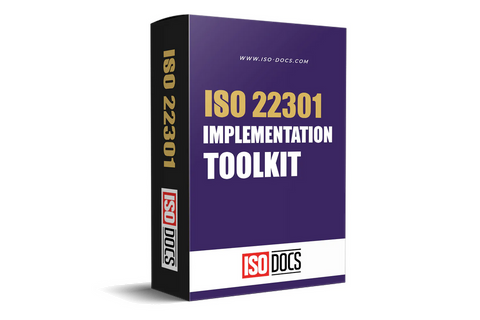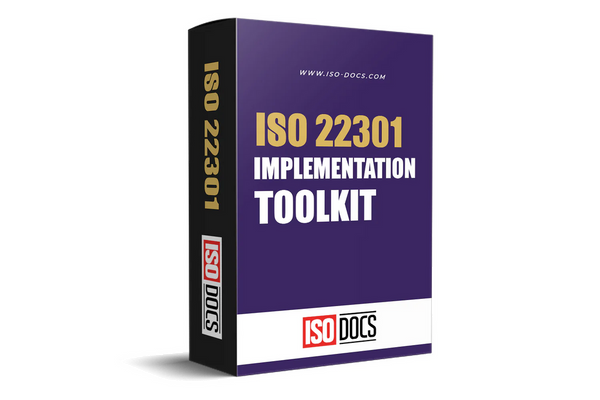ISO 22301 : Risk Assessment Matrix Template
The ISO 22301 Risk Assessment Matrix Template serves as a critical tool in the implementation of an effective Business Continuity Management System (BCMS). ISO 22301 is a globally recognized standard that outlines best practices for establishing, implementing, maintaining, and continually improving a BCMS. The Risk Assessment Matrix Template aligns with the principles of ISO 22301 by providing a structured framework for evaluating and categorizing potential risks to an organization's business processes.
This template enables organizations to systematically identify, assess, and prioritize risks, allowing for informed decision-making in risk mitigation and preparedness strategies. By utilizing this tool, businesses can enhance their resilience against disruptions, ensuring a proactive approach to managing uncertainties and safeguarding business operations. The ISO 22301 Risk Assessment Matrix Template plays a pivotal role in achieving compliance with ISO 22301 standards and, in turn, strengthens an organization's ability to navigate and thrive in the face of unforeseen challenges.
Importance of ISO 22301 Risk Assessment Matrix Template
- Comprehensive Risk Identification:The ISO 22301 Risk Assessment Matrix Template serves as a comprehensive tool for identifying and cataloging potential risks to an organization's business continuity. By systematically examining various aspects of operations, it ensures a thorough and methodical approach to risk identification.
- Structured Risk Assessment:This template provides a structured framework for assessing identified risks. It facilitates the evaluation of the likelihood and impact of each risk, allowing organizations to prioritize them based on their significance to business continuity.
- Prioritization of Risks:The tool enables organizations to prioritize risks based on their potential impact, helping allocate resources effectively. This prioritization is crucial for developing targeted and efficient risk mitigation strategies, focusing on areas with the highest potential impact on business continuity.
- Informed Decision-Making: With a clear understanding of identified and prioritized risks, decision-makers can make informed choices regarding risk management strategies. The template ensures that decisions are based on a systematic analysis of potential threats, reducing the likelihood of overlooking critical aspects of business continuity planning.
- Alignment with ISO 22301 Standards:The Risk Assessment Matrix Template aligns with the principles outlined in ISO 22301, a globally recognized standard for business continuity management. Using this template helps organizations adhere to ISO 22301 requirements, contributing to the establishment of a robust and compliant Business Continuity Management System (BCMS).
- Proactive Risk Mitigation: By providing a clear overview of potential risks, the template enables organizations to proactively develop and implement risk mitigation strategies. This proactive approach minimizes the impact of disruptions on business processes, enhancing overall resilience.
- Continuous Improvement:The template supports the concept of continual improvement as emphasized by ISO 22301. Organizations can regularly review and update their risk assessments based on changing circumstances, ensuring that their business continuity plans remain relevant and effective over time.
- Enhanced Resilience:Through the systematic identification, assessment, and prioritization of risks, the template contributes to the overall resilience of an organization. It empowers businesses to anticipate, prepare for, and respond to disruptions in a way that minimizes negative impacts on operations.
- Facilitation of Audits and Compliance:Utilizing the Risk Assessment Matrix Template aids in demonstrating compliance with ISO 22301 standards during audits. The structured approach to risk assessment and documentation ensures transparency and accountability in the business continuity management process.
- Cost-Effective Resource Allocation:Efficiently allocating resources to address the most critical risks identified in the matrix ensures a cost-effective approach to business continuity. This targeted resource allocation maximizes the effectiveness of risk management efforts while minimizing unnecessary expenditures.
Key components of ISO 22301 Risk Assessment Matrix Template
- Risk Identification Section:The template includes a dedicated section for systematically identifying potential risks to business continuity. This involves a comprehensive examination of internal and external factors that may impact critical business processes.
- Risk Classification Criteria:Clearly defined criteria for classifying risks based on their nature, severity, and relevance to business continuity. This ensures a standardized approach to categorizing risks, facilitating consistent evaluation across different organizational units.
- Likelihood and Impact Assessment:Provides fields or parameters for assessing the likelihood and impact of each identified risk. This quantitative or qualitative assessment allows for a nuanced understanding of the potential consequences and the probability of occurrence.
- Risk Prioritization Mechanism:Incorporates a mechanism for prioritizing risks based on the combination of likelihood and impact assessments. This prioritization aids in focusing attention and resources on the most critical risks that could significantly disrupt business operations.
- Risk Mitigation Strategies:A section dedicated to documenting proposed or implemented risk mitigation strategies. This involves outlining specific actions and measures to reduce the likelihood and impact of identified risks, ensuring a proactive approach to risk management.
- Responsibility Assignment:Clearly defines roles and responsibilities for managing and mitigating each identified risk. This ensures accountability within the organization and clarifies who is responsible for implementing specific risk mitigation measures.
- Monitoring and Review Mechanism:Incorporates a system for regularly monitoring and reviewing the effectiveness of risk mitigation strategies. This component supports the ongoing improvement of business continuity plans by enabling adjustments based on changes in the risk landscape.
- Documentation of Assumptions and Constraints:Provides space for documenting any assumptions made during the risk assessment process and constraints that may impact the implementation of risk mitigation strategies. This ensures transparency and helps in addressing potential uncertainties.
- Integration with Business Impact Analysis (BIA):Aligns with the outcomes of Business Impact Analysis, ensuring that the risk assessment matrix reflects the criticality of business processes. This integration enhances the overall coherence of business continuity planning efforts.
- Communication and Reporting:Includes a mechanism for documenting communication strategies and reporting protocols related to identified risks. This ensures that relevant stakeholders are informed in a timely manner, supporting effective crisis communication during business disruptions.
- Documentation of Risk Trends Over Time:Allows for the tracking of risk trends over time, facilitating a longitudinal analysis of changing risk landscapes. This documentation supports a dynamic and adaptive approach to business continuity planning in response to evolving threats.
- Alignment with ISO 22301 Standards:Ensures that the components of the risk assessment matrix are aligned with the requirements and guidelines outlined in ISO 22301. This alignment is crucial for organizations seeking certification and compliance with the international standard for business continuity management.
The Benefits of ISO 22301 Risk Assessment Matrix Template
- Systematic Risk Identification:The ISO 22301 Risk Assessment Matrix Template facilitates a systematic and structured approach to identifying potential risks to an organization's business continuity. This ensures a comprehensive overview of threats that may impact critical operations.
- Holistic Risk Assessment:Provides a framework for conducting a holistic risk assessment by considering various dimensions, including the likelihood and impact of each identified risk. This comprehensive analysis enables organizations to understand the full spectrum of potential disruptions.
- Prioritization of Critical Risks:Enables organizations to prioritize risks based on their severity and potential impact on business continuity. This prioritization assists in directing resources and attention to the most critical areas, enhancing the efficiency of risk mitigation efforts.
- Proactive Risk Management:Fosters a proactive approach to risk management by encouraging organizations to anticipate and address potential threats before they materialize. This proactive stance contributes to increased resilience and reduces the likelihood of severe business disruptions.
- Informed Decision-Making:Facilitates informed decision-making by providing a clear and organized representation of risks and their potential consequences. Decision-makers can use this information to develop effective risk mitigation strategies and allocate resources judiciously.
- Enhanced Business Continuity Planning:Strengthens the overall business continuity planning process by integrating risk assessment into the planning cycle. The template ensures that continuity plans are tailored to address the most significant risks, making them more robust and responsive.
- Compliance with ISO 22301 Standards:Assists organizations in achieving and maintaining compliance with ISO 22301 standards for business continuity management. The use of the risk assessment matrix aligns with the systematic and rigorous requirements outlined in the international standard.
- Resource Optimization:Contributes to resource optimization by helping organizations allocate resources more effectively. By focusing on high-priority risks, resources can be directed toward mitigating the most significant threats, reducing wastage and optimizing cost-effectiveness.
- Continuous Improvement:Supports a culture of continuous improvement by providing a mechanism for regular review and refinement of risk assessments. This iterative process ensures that risk management strategies evolve in response to changing internal and external circumstances.
- Facilitation of Communication:Enhances communication within the organization by providing a standardized and transparent method for conveying risk information. This fosters a shared understanding of potential threats and ensures that stakeholders are well-informed and prepared.
- Demonstration of Due Diligence:Serves as evidence of due diligence in risk management practices. The use of an ISO 22301 Risk Assessment Matrix demonstrates a commitment to systematically identifying, assessing, and managing risks, which can be crucial in regulatory compliance and stakeholder trust.
- Improved Crisis Response:Contributes to improved crisis response capabilities by ensuring that risks are thoroughly understood and that mitigation strategies are in place. This preparation enhances an organization's ability to respond swiftly and effectively during periods of disruption.
Conclusion
In conclusion, the ISO 22301 Risk Assessment Matrix Template stands as an indispensable tool for organizations committed to robust business continuity management. By providing a structured framework for systematic risk identification, thorough assessment, and prioritization, this template facilitates informed decision-making and proactive risk mitigation. Its alignment with ISO 22301 standards ensures a compliance-driven approach, offering a comprehensive solution for businesses aiming to establish and maintain a resilient Business Continuity Management System (BCMS).
Moreover, the template's ability to optimize resource allocation, enhance communication, and foster a culture of continuous improvement makes it a cornerstone in fortifying an organization's ability to navigate and overcome disruptions. As businesses face an increasingly complex risk landscape, the ISO 22301 Risk Assessment Matrix Template emerges not only as a practical tool but also as a strategic asset in fortifying the foundations of business continuity and long-term sustainability.



